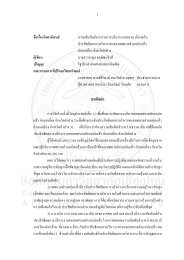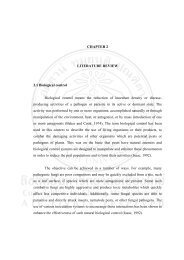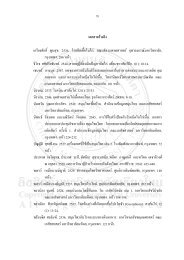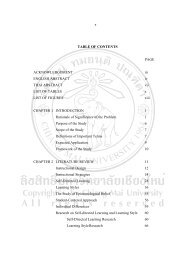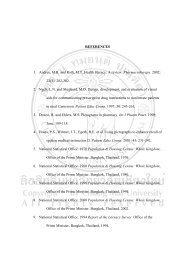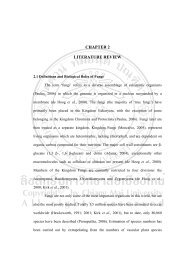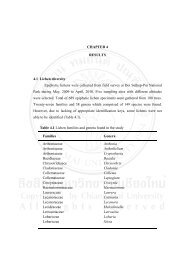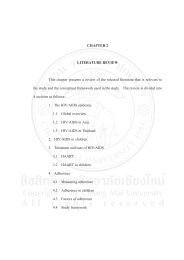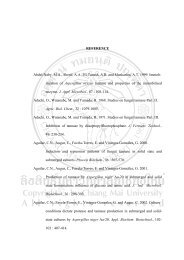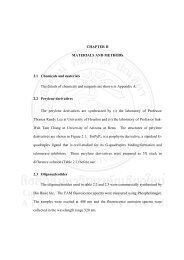prevalence and molecular characteristics of vibrio species in pre ...
prevalence and molecular characteristics of vibrio species in pre ...
prevalence and molecular characteristics of vibrio species in pre ...
Create successful ePaper yourself
Turn your PDF publications into a flip-book with our unique Google optimized e-Paper software.
A. Cool<strong>in</strong>g <strong>and</strong> freez<strong>in</strong>g<br />
33<br />
Rapid <strong>and</strong> efficient cool<strong>in</strong>g to 5 °C will <strong>pre</strong>vent the growth <strong>of</strong> V.<br />
parahaemolyticus. Vibrio vulnificus is more sensitive to cold storage than V.<br />
parahaemolyticus <strong>and</strong> reduces with approximately 0.04 log units/day under normal<br />
cold temperature storage. Even though V. cholerae be reduced <strong>in</strong> cold storage, they<br />
should not be relied on as <strong>pre</strong>ventive measures (FAO, 2003). It has been shown that<br />
V. cholerae can survive under chilled <strong>and</strong> frozen temperatures on shellfish due to<br />
<strong>pre</strong>sence or absence <strong>of</strong> the chit<strong>in</strong>-conta<strong>in</strong><strong>in</strong>g carapace <strong>of</strong> shrimp, which has a<br />
cryoprotective effect on the pathogen (Shimodori et al., 1989). Sodium-<br />
metabisulphate is traditionally used <strong>in</strong> shrimp to control non-microbiological spoilage<br />
known as black spot. A study reported significant decreases (up to 1.8 log units) <strong>of</strong> V.<br />
cholerae on chilled sodium-metabisulphate- treated, compared to untreated chilled<br />
prawns (Januário <strong>and</strong> Dykes, 2005).<br />
B. Heat<strong>in</strong>g<br />
Vibrio is very sensitive to the heat (Table 8). Boil<strong>in</strong>g temperature is very<br />
harmful to the V. cholerae O <strong>in</strong> shrimp samples with or without carapace <strong>and</strong><br />
complete destruction occurs with<strong>in</strong> 1-2 m<strong>in</strong>utes after exposure to the temperature<br />
(Nascumento et al., 1998). V. parahaemolyticus shows a >7 log reduction <strong>in</strong> viable<br />
cell count when heated at 55 °C for 2 m<strong>in</strong>utes (Yeung <strong>and</strong> Boor, 2004). Therefore<br />
low heat pasteurization (50 °C for up to 15 m<strong>in</strong>) can be applied for reduction <strong>of</strong><br />
Vibrio <strong>in</strong> the seafood (Andrews et al., 2003).<br />
Table 9: Heat resistance <strong>of</strong> Vibrio spp. (FAO, 2003)<br />
Vibrio <strong>species</strong> Heat resistance (D value)<br />
V. cholerae D55 =0.24 m<strong>in</strong><br />
V. parahaemolyticus D60 =0.71 m<strong>in</strong><br />
V. vulnificus D50 =1.15 m<strong>in</strong> (buffer); 0.66 m<strong>in</strong><br />
(oysters)




